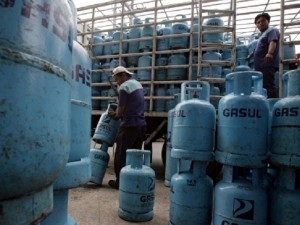Gov’t says LPG supply to remain stable
MANILA, Philippines—Amid mixed speculation on liquefied petroleum gas (LPG) prices next month, the Department of Energy (DOE) said Wednesday it expected supply of the cooking fuel to remain stable.
Despite recent changes in the industry, including the shutdown of Shell’s underutilized import and refinery facility in Batangas and the race among independent players to build direct LPG import facilities in the Visayas, Energy Secretary Carlos Jericho Petilla said he was more concerned about logistics rather than supply.
Since independent LPG retailers have started to build refilling plants and depots for the Visayas and Mindanao markets, existing retailers in Luzon would have to bear additional transport cost in getting supply from other places such as Liquigaz’s refinery in Bataan.
“Shell shut down its LPG import facility in Batangas because it was running at just about 10 percent of capacity,” Petilla said. Others with import facilities reported the same problem: Underutilization. This means there were too many independent LPG players and margins have become so low, Petilla said.
LPG sellers would have to start signing bulk contracts to keep their product prices stable or bear any additional cost in sourcing from Bataan if they insisted on spot buying, Petilla said.
Article continues after this advertisement“DOE is actually revisiting market studies. We are also asking independent players to get individually certified and give us feedback on their demand. Then we can get a clearer picture of what the actual LPG requirement is,” Petilla said.
Article continues after this advertisementThere are mixed speculations on near-term LPG price movements. LPG Marketers Association Rep. Arnel Ty recently said LPG prices might increase following the closure of Shell’s terminal in Batangas. However, contract prices worldwide are going down. Other industry sources have also said that there might in fact be a rollback in LPG prices next month. If this pushes through, it would be the second straight month of price cuts for LPG. On Jan. 1, 2014, retailers greeted the new year with a price rollback due to softer international contract prices.
As for Ty’s suggestion that the government take over Shell’s LPG facility in Batangas, Petilla said: “We will consider that only if there is clear and present danger. For now we only see additional logistical cost for those refillers in the southern part of Luzon, but in terms of supply, it seems to be sufficient.”
The House of Representatives Energy Committee reported last year that a market survey showed that LPG prices in Visayas and Mindanao to be generally higher by P75 to P100 per 11-kilogram cylinder compared to Luzon. This presents much growth opportunity for independent refillers.
Ty urged the DOE to reactivate the closed Shell terminal for 12 to 36 months—the time required for other oil firms to put up an alternative facility.
Until it was shut down, he said Shell’s LPG import terminal was the primary source of cooking gas supplies for Southern Luzon. “Of the 25 million kilos of LPG that used to come out of the Shell terminal every month, 15 million kilos were brought in by Shell from abroad, while the balance of 10 million kilos came from the local production of Shell’s adjacent oil refinery,” Ty said.
Since the terminal’s closure, Southern Luzon has had a large LPG supply deficit of around 15 million kilos a month since Shell has stopped importing the cooking gas, Ty pointed out.
According to him, LPG supply in Southern Luzon is now down to just 10 million kilos every month—the volume being locally produced by Shell’s refinery.
“This has put upward pressure on prices because some of the supplies meant for Metro Manila and other parts of Luzon are now being diverted to Southern Luzon at higher prices to cover the extra transport costs from the LPG terminals in Bataan,” Ty explained.
“Actually, the problem posed by the decommissioning of Shell’s LPG import terminal could hit us earlier than expected as Shell only recently served notice that it is temporarily shutting down its oil refinery this March for maintenance activities,” Ty said.
This means that Shell’s refinery will also temporarily stop producing Southern Luzon’s leftover supply of 10 million kilos of LPG a month—now being stored in a smaller bay tank with a capacity of just three million kilos, according to Ty.
“Thus, the only option left for government, in order to shield consumers from potentially harsh LPG price increases, is for the DOE to takeover Shell’s idle import terminal and to run the facility so as to enable other industry players, including the independents, to bring in extra supplies on their own,” Ty said.
